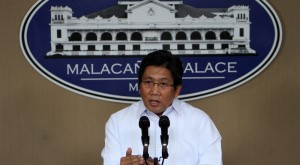Palace refuses to give info on 116 projects funded by DAP, eyes SC appeal
MANILA, Philippines—A day after asking senators to account for funds they had received from the Disbursement Acceleration Program (DAP), Malacañang rejected calls on Tuesday that it release its own list of 116 projects funded by the facility, which the Supreme Court last week declared unconstitutional.
Communications Secretary Herminio Coloma insisted that the Palace was “not withholding” the list earlier submitted by the Department of Budget and Management (DBM) to the Supreme Court during its deliberations on the DAP and before the magistrates by a 13-0 vote struck it down.
“We are just saying that we are conducting a comprehensive review of the [court] decision,” Coloma told reporters who spent much of the Malacañang press briefing asking why the Palace had not released the list.
“It is our view that the discussion of the projects is part of the active case and we observe certain rules whenever there is still an active case,” he added.
Despite this so-called “active” case, presidential spokesperson Edwin Lacierda last week maintained that the “unconstitutionality” of the practices under the DAP did not necessarily mean that the executive branch had committed a “criminal” act.
Article continues after this advertisementLacierda insisted that DAP funds—basically government savings pooled by the DBM—were “beneficial” to the public, citing such projects as school buildings and the purchase of Doppler radars to improve weather forecasting.
Article continues after this advertisementOn Monday, he said “it would be in the best interest of everyone to see how [senators] spent their funds if they did receive the DAP.”
Even if Malacañang refused to release the list of DAP projects so far, Coloma said it continued to “abide by the principle of accountability of public officials.”
He said the Office of the Solicitor General (OSG) received a copy of the high court’s decision only on July 4. Under the rules, he said the government had 15 days to file a motion for reconsideration.
Asked if the Palace was still confident that the high court would re-consider its 13-0 decision against the DAP, Coloma said: “We’re not expressing any view or suggestion.”
“What we’re only saying is that we have a right under the law… to file a motion for reconsideration,” he added.
Budget Secretary Florencio Abad earlier admitted that “9 percent” (or P12.8 billion) of DAP funds had been coursed through legislators, a move akin to how congressional pork barrel had been used before.
Last year, President Aquino asserted that the DAP was different from the graft-ridden Priority Development Assistance Fund (PDAF), a position Coloma echoed on Tuesday, by saying: “PDAF is different from DAP.”
Some of the DAP-funded projects were listed in the high tribunal’s 92-page decision against the program.
Among the big-ticket items were the Cordillera People’s Liberation Army, which supposedly got P1.5 billion, and the Moro National Liberation Front, which received P1.8 billion.
The list also included P10 billion for the National Housing Authority for the “relocation of families living along dangerous zones.” A similar amount was set aside for the Bangko Sentral ng Pilipinas on top of P20 billion in “equity infusion.”
Another P5.4 billion was realigned for “landowners’ compensation under the Department of Agrarian Reform,” P8.6 billion for a “comprehensive peace and development program” in the Autonomous Region in Muslim Mindanao, and P6.5 billion to “augment” the internal revenue allotments of local government units.
A total of P4 billion was listed for the Department of Education’s “school infrastructure projects” under the public-private partnership scheme.
In the decision, the Supreme Court cited the OSG’s argument that the 116 DAP-funded projects “had appropriation covers and could be properly accounted for because the funds were released following and pursuant to the standard practices adopted by the DBM.”
But the court concluded that based on evidence submitted by the DBM, DAP funds had been allocated to projects that “were not covered by any appropriations in the pertinent GAAs [General Appropriations Act].”
In September 2013, Sen. Jinggoy Estrada revealed in a privilege speech that senators who voted to convict Chief Justice Renato Corona each received an additional PDAF allocation of P50 million as an “incentive.”
Abad subsequently confirmed that 20 senators had received the additional largesse—some as much as P100 million—and disclosed for the first time that this came from the little-known DAP. He denied the additional amounts were a “bribe.”
Senate President Franklin Drilon, who got the biggest amount from the DAP among the senators in the 15th Congress, reiterated on Tuesday that his DAP funds were spent properly, and released documents to show that the P100 million he had received was used to construct the Iloilo Convention Center.
“I believe that all projects which involve public funds should be disclosed to the public, and open to scrutiny anytime,” he said in a statement.
On Monday, Sen. Antonio Trillanes IV also released documents pertaining to the P50-million funding he received from projects, and which DBM documents stated came from the DAP.
He said that as far as his office was concerned, this was part of his PDAF. The projects consisted mostly of the construction, repair and rehabilitation of multipurpose buildings, fire stations, classrooms, school buildings, and transient quarters at Veterans Memorial Medical Center.
Sen. Francis Escudero has said his DAP funds went to hospitals, medical assistance for indigent patients, and the construction and rehabilitation of public markets, which were also projects funded by his PDAF.
But Escudero also said earlier he could not tell which of his projects were funded by the DAP, and which were funded by the PDAF.
Sen. Pia Cayetano also released a list of her recommended projects worth P50 million funded by the DAP, “in the interest of transparency.” The projects included the rehabilitation of the Ultra and UP track ovals, a cancer ward at Philippine Children’s Medical Center, construction and rehabilitation of classrooms and health centers, among others.
RELATED STORIES
SC declares parts of DAP unconstitutional
